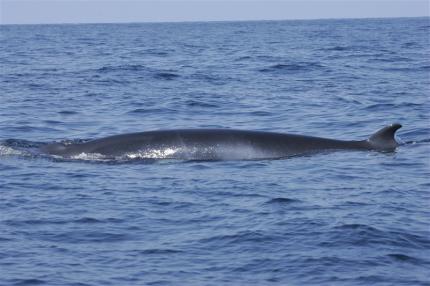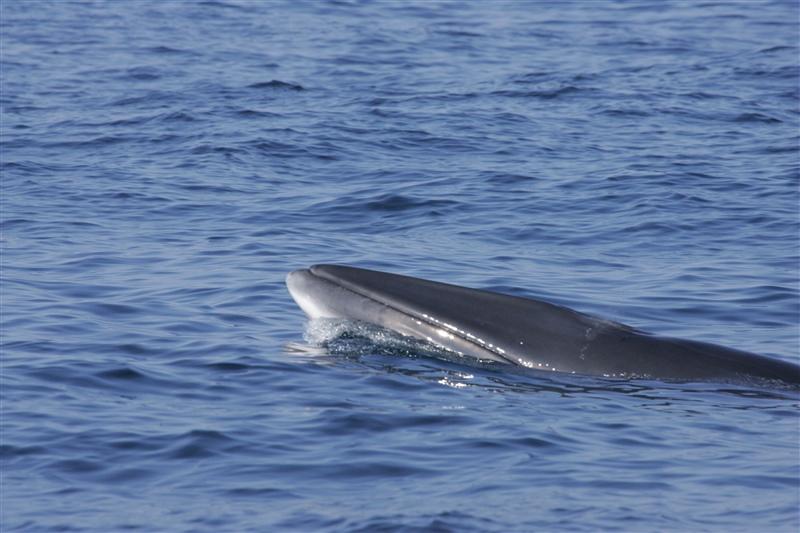Low-
Moderate
Minke whales are found across the globe and are considered stable throughout much of their range. The stock of minke whale along the U.S. west coast is estimated at just over 600 whales, with an unknown trend. Ship strikes and fisheries entanglements may hinder population growth.
Marine mammals are protected under the Marine Mammal Protection Act. To report a dead, injured or stranded marine mammal in Washington, please call the National Oceanic and Atmospheric Administration (NOAA) West Coast Region Stranding Network hotline: 1-866-767-6114.
Description and Range
Physical description
The smallest baleen whale in North American waters, the minke whale can weigh up to ten tons and be up to 35 feet in length. Their body is dark on top and white underneath, with a pale chevron behind the head. When diving, they arch and expose much of their backs but, unlike most baleen whales, do not show the tail (“fluke”).
Ecology and life history
This species of whale is usually solitary or found in groups of two to three individuals, but occasionally forms larger loose aggregations with many animals at favored feeding locations. Both coastal and pelagic waters are occupied. Important habitat features may include water temperature, depth, and underwater topography. Some populations migrate between higher latitude waters in summer and lower latitude waters in winter, while others maintain home ranges and are not migratory. Adults tend to migrate farther than immatures.

Diet consists mainly of small schooling forage fishes and krill.
Gestation lasts 10 to 11 months. In the northern hemisphere, single calves are born from November to March. Young are weaned by four to six months of age; calving occurs every one to four years. Age of sexual maturity is usually six to eight years. Lifespan is estimated to reach 50 years.
Geographic range
Minke whales are found throughout the world's oceans in tropical, temperate, and subpolar waters. Global population size is unknown, but the species is relatively common overall.
Minke whales are rare along the U.S. west coast and belong to the California/Oregon/Washington Stock. Although this stock was never commercially harvested, it is estimated to be 636 whales based on surveys conducted in 2008 and 2014. Stock trend is not known. The stock is non-migratory. A few members of the stock reside in Washington’s inner marine waters for part of the year.
For worldwide distribution and other species' information, check out NatureServe Explorer and the International Union for Conservation of Nature Red List.
Climate vulnerability
Sensitivity to climate change
Low-
Moderate
Though limited information is available regarding the sensitivity of minke whales to climate change in the North Pacific, given their migration patterns and the wide range of conditions that they experience, they are unlikely to have significant physiological sensitivity to climate-induced changes in ocean conditions. Instead, their sensitivity will more likely relate to potential fluctuations in the availability of preferred prey, including krill, copepods, and forage fish (e.g., herring). Though changing oceanographic conditions such as warming sea temperatures and greater ocean acidity could lead to declines in prey availability, studies have shown that minke whales are generalists and readily switch between different types of prey depending on abundance, which allows them to adjust to seasonal variability in prey. Nevertheless, potential declines in certain types of prey could increase the sensitivity of this species.
Exposure to climate change
Moderate
- Increased ocean temperatures
- Increases in ocean acidity
Conservation
Conservation Threats and Actions Needed
Conservation threats for the minke whale in Washington include a lack of resource data collection to improve the assessment of occurrence and understand threats to the species in the state. Actions needed to address this issue is to expand efforts to document the species in Washington waters.
See the Climate vulnerability section for information about the threats posed by climate change to this species.
Resources
References
Anderwald, P., P. G. H. Evans, R. Dyer, A. Dale, P. J. Wright, and A. R. Hoelzel. 2012. Spatial scale and environmental determinants in minke whale habitat use and foraging. Marine Ecology Progress Series 450:259-274.
Caretta, J.V., E.M. Oleson, K.A. Forney, M.M. Muto, D.W. Weller, A.R. Lang, J. Baker, B. Hanson, A.J. Orr, J. Barlow, J.E. Moore, and R.L. Brownell Jr. 2021. U.S. Pacific Marine Mammal Stock Assessments: 2020. U.S. Department of Commerce, NOAA Technical Memorandum NMFS-SWFSC-646.
NOAA Fisheries Office of Protected Resources. http://www.nmfs.noaa.gov/pr/species/mammals/cetaceans/minkewhale.htm
Reilly, S. B., J. L. Bannister, P. B. Best, M. Brown. 2008. Balaenoptera acutorostrata. The IUCN Red List of Threatened Species. Version 2014.2. http://www.iucnredlist.org/details/full/2474/0
